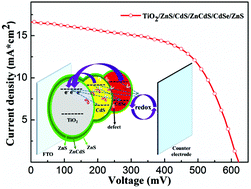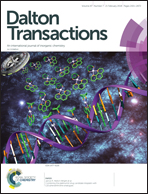Charge recombination control for high efficiency CdS/CdSe quantum dot co-sensitized solar cells with multi-ZnS layers†
Abstract
ZnS as an inorganic passivation agent has been proven to be effective in suppressing charge recombination and enhancing power conversion efficiency (PCE) in quantum dot-sensitized solar cells (QDSCs). In the present study, we constructed a novel TiO2/ZnS/CdS/ZnCdS/CdSe/ZnS photoelectrode via successive ionic layer adsorption and reaction (SILAR) and chemical bath deposition (CBD). The complementary effects of multi-ZnS layers on the optical and electrochemical performance of the QDSCs were systematically investigated. The multi-ZnS can not only facilitate the growth and distribution of QDs, but also suppress the different interface charge recombination effectively. We suggest that the formation of the ZnCdS intermediate layers via ion-exchange route during CBD process contributes to the higher photoelectrochemical cell performance of the QDSCs with the middle ZnS layer. When the three-layer ZnS was employed in CdS/CdSe co-sensitized system, the PCE reached 6.05%, which is much higher than that observed for solar cells with the conventional single ZnS treatments and the two layers inserted at the interface between CdS QDs and CdSe QDs and electrolyte (4.80% and 5.42%, respectively).



 Please wait while we load your content...
Please wait while we load your content...